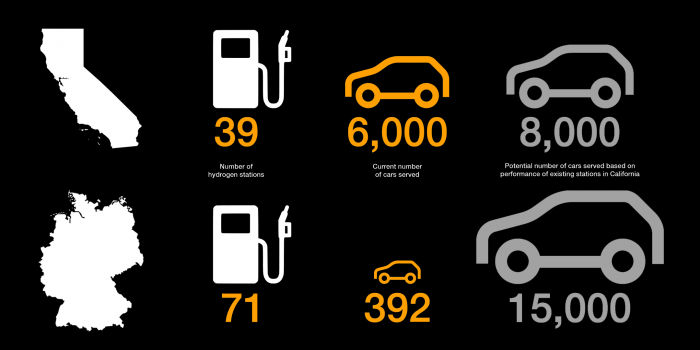By guest author Christoph Reifenrath.
When Bertha Benz undertook the first long-distance automobile journey in 1888, there was not a single gas station in the world. Today, more than 1.2 billion combustion engine vehicles populate the roads with possibilities to refuel seemingly at every corner. Even if we are far away from a comprehensive worldwide charging network for electric vehicles, there are more than 6 million EVs running today. This is a plea for less “if and when,” and for more confidence in the power of developing markets, pioneer spirit and technological openness.

One of the most widely read German news websites, Spiegel Online, recently published an article on hydrogen cars titled “Five reasons why hydrogen cars are hardly in demand,” in which the perceived flop of the technology is discussed.
One of the main reasons outlined in the article says that the number of hydrogen filling stations is far from sufficient to guarantee a nationwide supply; a point that has often been used as an explanation for the slow spread of new technologies – most recently again and again in arguments about Electric Vehicles. In the case of hydrogen technology, however, the analogy to the chicken and egg dilemma is even less convincing.
How so? As Spiegel Online correctly points out, there are currently only 392 registered hydrogen vehicles in Germany, but 71 hydrogen filling stations. Assuming that the locations of the stations and registered cars are somehow evenly spread out, simple math shows that each filling station has to serve only six hydrogen vehicles as of today. To take this further and under the assumption of a sufficient delivery capacity of each individual hydrogen filling station: Even with an average fill-up duration of ten minutes, the current network of 71 filling stations could potentially fill up all 392 registered hydrogen vehicles in less than one hour.
Within the course of a 12-hr day, over 5,000 cars could be refilled, which is more than 13 times the actual number of registered vehicles. Another important fact to consider is that hydrogen vehicles do not need to be refueled on a daily basis. A look at the average driving distances in Germany shows that 95 percent of all cars travel less than 60 miles on any given day. Currently available hydrogen vehicles already achieve ranges of 250 to 335 miles per tank. This means that hydrogen car drivers in most cases would only have to fill up once per work week. The theoretical number of hydrogen vehicles that could be refueled at already existing filling stations, would therefore –calculated conservatively – increase by a factor of three, bringing the total number to around 15,000 vehicles that could be fueled.
Looking at the numbers for the US, we get similar results: In California – which is quite comparable to Germany in terms of area and population size – hydrogen vehicles already belong to the regular street scene. The filling station-to-car ratio here shows that the calculation applied before is by no means unrealistic. There are around 6,000 registered hydrogen vehicles in California, but only 39 operating hydrogen filling stations. That means that approximately 154 vehicles share a hydrogen station. And most commonly there are no signs of supply bottlenecks. Moreover, infrastructure experts claim that the network of hydrogen filling stations in California could supply up to 8,000 vehicles, based on the actual performance of existing dispensers. Transferring these real-life California numbers back to Germany, approximately 14,500 hydrogen vehicles could already be fueled today by the existing stations, proving that there is no hydrogen fuel bottleneck in Germany.
Like every technology, hydrogen fueled cars have advantages and disadvantages. However, a look at California shows that their adaption is a question of strategy, will, and in the end money. Hydrogen vehicles can be leased here for USD 399 per month (duration of 36 months, plus taxes and down payment). In addition, there is a USD 15,000 fuel voucher and various other incentives – an offer that has already convinced 20 times more customers than in Germany. So there is no need to prematurely kill a promising technology, with an argument that simply does not apply. Some eggs have already been laid and we should be a little more confident that chickens will emerge from it.
